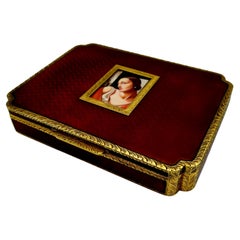Roberto Masi
1990s Italian Art Deco Decorative Boxes
Gold Plate, Sterling Silver, Enamel
People Also Browsed
2010s British Jewelry Boxes
Maple
Antique 15th Century and Earlier Egyptian Egyptian Figurative Sculptures
Limestone
Vintage 1920s Danish Scandinavian Modern Bookcases
Mahogany
Antique Early 1900s French Art Nouveau Bird Cages
Iron
Vintage 1970s Italian Baroque Cigar Boxes and Humidors
Sterling Silver, Enamel, Gold Plate
Antique 19th Century Swiss Neoclassical Decorative Boxes
Metal
1920s Art Deco Portrait Paintings
Oil
Antique Mid-19th Century English High Victorian Taxidermy
Other
18th Century Old Masters Figurative Paintings
Canvas, Oil
1990s English Decorative Boxes
Gold
21st Century and Contemporary American Art Deco Decorative Boxes
Gold, Silver, Enamel
Vintage 1970s Italian Modern Decorative Boxes
Gold Plate, Sterling Silver, Enamel
20th Century French Art Deco Panelling
Alpaca, Mirror, Beech, Plywood, Paper
Antique 19th Century English Victorian Tea Caddies
Silver
Antique 19th Century Italian Apothecary Cabinets
Glass, Walnut
1990s Italian Louis XVI Decorative Boxes
Gold, Gold Plate, Sterling Silver, Enamel
Roberto Masi For Sale on 1stDibs
How Much is a Roberto Masi?
A Close Look at Contemporary Art
Used to refer to a time rather than an aesthetic, Contemporary art generally describes pieces created after 1970 or being made by living artists anywhere in the world. This immediacy means it encompasses art responding to the present moment through diverse subjects, media and themes. Contemporary painting, sculpture, photography, performance, digital art, video and more frequently includes work that is attempting to reshape current ideas about what art can be, from Felix Gonzalez-Torres’s use of candy to memorialize a lover he lost to AIDS-related complications to Jenny Holzer’s ongoing “Truisms,” a Conceptual series that sees provocative messages printed on billboards, T-shirts, benches and other public places that exist outside of formal exhibitions and the conventional “white cube” of galleries.
Contemporary art has been pushing the boundaries of creative expression for years. Its disruption of the traditional concepts of art are often aiming to engage viewers in complex questions about identity, society and culture. In the latter part of the 20th century, contemporary movements included Land art, in which artists like Robert Smithson and Michael Heizer create large-scale, site-specific sculptures, installations and other works in soil and bodies of water; Sound art, with artists such as Christian Marclay and Susan Philipsz centering art on sonic experiences; and New Media art, in which mass media and digital culture inform the work of artists such as Nam June Paik and Rafaël Rozendaal.
The first decades of the 21st century have seen the growth of Contemporary African art, the revival of figurative painting, the emergence of street art and the rise of NFTs, unique digital artworks that are powered by blockchain technology.
Major Contemporary artists practicing now include Ai Weiwei, Cecily Brown, David Hockney, Yayoi Kusama, Jeff Koons, Takashi Murakami and Kara Walker.
Find a collection of Contemporary prints, photography, paintings, sculptures and other art on 1stDibs.
Finding the Right Mixed-media for You
Mixed media is a type of art that sees artists using a range of materials or more than one medium. Find a range of mixed media paintings and other artworks for your space today on 1stDibs.
Mixed media is distinct from multimedia, which describes art involving electronic media, including video, computers and digital elements. Artists combine painting, drawing, photography and sculpture for mixed media art. Instead of sticking to one form, they aim to break boundaries and create unique pieces. Pop art is one of the vibrant periods for mixed media art, with Jasper Johns and Robert Rauschenberg among its most fabled producers. Rauschenberg, like many mixed media artists, used found objects in his work, from cast-off furniture to newspapers.
Collage is one of the most well-known areas of mixed media. Artists use various types of paper, fabric, photographs and more to create one cohesive work. A type of collage is assemblage, which involves 3D objects.
While artists may use fabric in collage, it can be the very substance of the art itself. Fabric art makes extensive use of texture. Artists may paint or embroider on fabric to create layers of texture and color to evoke a specific feeling. They can also transfer photos onto fabric for innovative ways to display visuals.
Resin-based art has clean, sharp lines and a definitive shape. Resin is a liquid that hardens to a high-gloss surface and is used to seal wood, counters and floors. Resin can also seal artwork, and many artists tint it using pigment powder, ink, spray paint and other vivid materials. If water is added, the resin will turn milky instead of being completely transparent. It’s common for artists working in mixed media to use resin on nontraditional surfaces like glass, wood, metal and stone. This creates a shine that’s perfect to brighten a dull space in the home or office.
Find mixed media paintings and other art for sale on 1stDibs.
